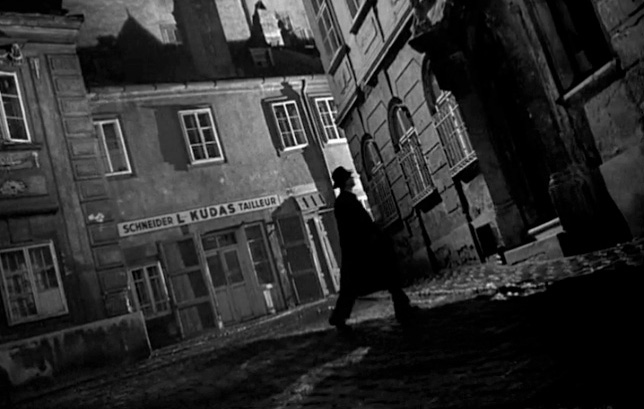Reviews of Classic Movies: 'The Third Man'
I may be a news junkie, but I’ve never really focused that heavily on geopolitical stories like the wars in Iraq and Afghanistan. And yet I know that as NATO troops pull ground troops out of those regions, both countries will have to continue the complex process of rebuilding. Local governments will try to stabilize, and there may be a lot of work ahead to deal with people who have taken advantage of the upheaval to make a quick buck.
As a member of that often-discussed Millenial generation, it’s fascinating to have grown up aware of these events in the Middle East, and then to watch a movie like 1949’s The Third Man, which is set in a remarkably similar context to the most recent conflicts.
Instead of Iraq and Afghanistan, the movie takes place in Vienna, in the aftermath of the Second World War. The film throws us into an underworld of slippery criminals and the coalition government trying to keep them under control. As long shadows dance down cobblestone streets, we see a surprisingly relevant story play out, folding together a commentary on the aftermath of war with some of the most striking film noir cinematography ever captured on camera.
Our everyman entry point into the story is Holly Martins (Joseph Cotten), an unemployed pulp fiction novelist who arrives in Vienna for a writing job promised to him by Harry Lime (Orson Welles). We find out early on that Harry’s line of work is hazy and likely not very legal, and Martins is shocked to learn Harry was killed shortly before Martins arrived, after being hit by a truck in the street outside his apartment.
Martins initially decides to pack up and end his European escapades before they begin, but he is soon drawn into investigating what he believes was Harry’s murder – with Martins’ pursuit centred on the mysterious “third man” who allegedly helped carry Harry’s body to the sidewalk after the truck accident. As Martins unfolds the truth of Harry’s activities in the Vienna underworld, he uncovers a plot to exploit the medical aid flowing into the city, and the film culminates in a brilliant chase through the crumbling ruins of the bombed-out city and down into the cascading sewers below.
Watching a movie like The Third Man for the first time in 2014 leads to a familiar experience I often have with classic movies. I begin recognizing the original techniques that countless directors have referenced in later films – the aforementioned deep shadows draping the scenes, or the oblique camera angles that make the world of the film look suitably off-kilter. As a result, the film instantly grants any burgeoning movie buff a better appreciation of the noir genre – a type of film I happen to love.
As essential as the visuals are, the scenario of the movie is the most important to new viewers. And while I began this review by drawing a connection between The Third Man and the current events it resembles, that’s not to say that the movie overwhelms us with those themes.
Granted, Martins does take some time to criticize the mismanagement of the city by its overseers, the alliance of British, American and Russian military officers. Aside from that, Reed uses post-war Vienna more for its atmospheric setting – like the piles of rubble that Martins tumbles down near the film’s climax, or the abandoned carnival rides where Martins arranges an important meeting. In 1949, the film seems to have had a head start on the post-apocalyptic genre that has now become so popular, as its characters wander through an utterly transformed city, trying to scratch a living out of the dust.
In its depiction of the lengths to which people must go to outlast the effects of war, The Third Man challenges modern audiences to re-examine the stories that emerge from war-torn countries of 2014. Are the distinctions between the heroes and villains as clear-cut as they are made out to be? Like Harry Lime in this film, what else is waiting to be pulled into the light?
Unfortunately, despite the compelling questions posed by The Third Man, I wasn’t surprised to find that the only female character in the film, Harry’s former girlfriend Anna (Alida Valli), doesn’t have much to do in the film. As is typical of many mainstream productions (then and now), Anna operates more at the behest of the various men trying to influence her. But I was happy to see Anna seize some control over herself in the film’s final shot – a subtle, powerful suggestion that her days of being shunted around are over.
A note on the score: Reed's film is filled with zither music, which does a lot to orient us in the culture of Vienna. Even so, I found the instrument tiresome in some scenes, especially during sequences that are meant to convey menace or tension – the zither ends up sounding too boisterous, or even comical, and it took me out of the story to an extent.
For any fan of film noir (or 1940s film in general), The Third Man is a must-see. It’s also fascinating to watch or re-watch from our modern context, and question what the movie might teach us about our own place in history - a hallmark of a timeless film. The Third Man gets three stars out of four.
Have you seen Carol Reed’s film? If so, what did you think? Do you think we can apply anything from its story to current events? Join the discussion in the comments section below, and if you liked this review, share it with your friends and followers!




